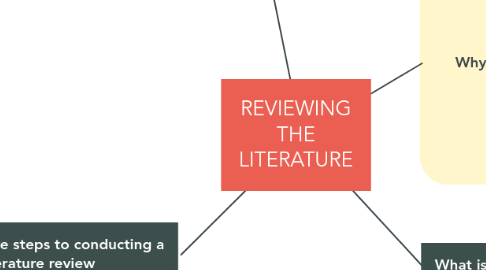
1. Differ
1.1. Quantitative
1.1.1. susbtantial use of literature
1.1.2. confirms or desconfirms the findings
1.2. qualitative
1.2.1. minimal use of literature
1.2.2. support existing findings
2. Five steps to conducting a literature review
2.1. Identify key terms
2.1.1. Preliminary"working title" and select key words
2.1.2. Create a general question
2.1.3. Use words that authors report in the literature.
2.1.4. Look in a catalog of terms to fi nd words that match your topic.
2.1.5. Go to the bookshelves in a college or university library,
2.2. Locate literature
2.2.1. Use academy libraries
2.2.2. Use primary and secondary sources
2.2.3. Search different types of literature such as summaries,encyclopedias,handbooks, databases etc.
2.3. Critically evaluate and select the literature
2.3.1. Is it relevant?
2.3.2. Is it good, accurate source?
2.4. Organize the literature
2.4.1. Reproducing, Downloading, and Filing
2.4.2. Taking Notes and Abstracting Studies
2.4.2.1. quantitative ◆ Research problem ◆ Research questions or hypotheses ◆ Data collection procedure ◆ Results of the study
2.4.2.2. Qualitative ◆ Research problem ◆ Research questions ◆ Data collection procedure ◆ Findings
2.4.3. Constructing a Literature Map
2.5. Write a literature review
2.5.1. Using an appropriate style to write complete references for these summaries and to develop headings for the literature review
2.5.2. Employing specifi c writing strategies related to the extent of the review, the type ofreview, and the concluding statements in a review,
